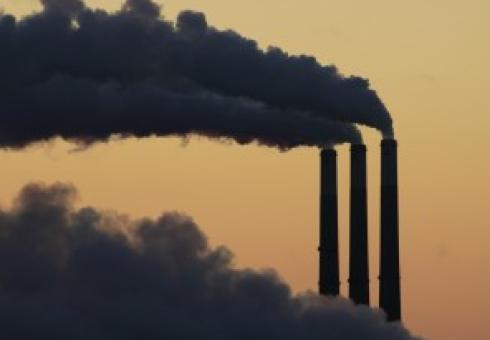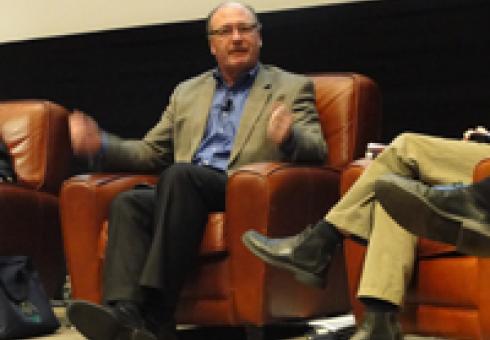News + Media
There are two ways to think about the cost of energy. There’s the dollar amount that shows up on our utility bills or at the pump. And then there’s the “social cost” — all the adverse consequences that various energy sources, from coal to nuclear power, end up foisting on the public.
New York Times’ Andrew Revkin shares lessons with MIT faculty, students at Earth Day colloquium.
From the high Himalayas to the poles, the world’s glaciers are melting. What does this mean for your community and our shared Earth? David Breashears presents his stunning new images of the Himalayan glaciers to mark the MIT Museum’s opening of its special exhibition by GlacierWorks: Rivers of Ice: Vanishing Glaciers of the Greater Himalaya. Along with David Breashears, the symposium brings together scientists and community members to debate your questions about our climate, environment, water supply and much more.
Toyota’s Tom Stricker shares his view with MIT students, faculty
Video: Watch the event
As gasoline prices continue to remain high, with the nationwide average jumping 19 cents a gallon in March, Americans and automakers alike are investing in alternatives. But what’s the most effective way forward for the auto industry? Toyota’s Tom Stricker — the company's Vice President, Technical & Regulatory Affairs — gave his take on Wednesday, April 18, during an event at MIT co-sponsored by the Joint Program on the Science and Policy of Global Change and the MIT Energy Initiative.
With the advisement of several Joint Program on Global Change researchers—including the co-director Ron Prinn and co-director emeritus Jake Jacoby—the MIT Museum opened a new exhibition “Rivers of Ice: Vanishing Glaciers of the Greater Himalaya.” The exhibit draws from mountaineer and filmmaker David Breashears’ breathtaking photographs, and places them in context with those of earlier mountaineer photographers—revealing the glacial melt that has occurred over time.
Breashears, who took the photos throughout his forty-five expeditions to the Himalaya, views the Rivers of Ice exhibition as an opportunity to trigger public dialogue as scientists and policymakers work to better understand what exactly is happening to the glaciers of the Greater Himalaya. Formed by the collision of continents, the water from the glacial ice melt in the Himalaya contributes to watersheds that serve the drinking, agriculture and business needs of more than 1 billion people throughout Asia. As the snow cover melts and the glaciers of the Greater Himalaya retract and change, the need for greater and more detailed understanding of their importance to human and ecological systems increases.
Breashears hopes the exhibit—and a related symposium taking place on Saturday, April 21—will provide insight into some of the groundbreaking research being done to better understand the glaciers’ potential impact on global environmental issues.
Rivers of Ice, once viewed, cannot be forgotten. By experiencing the photography 'in the round' and at large scale, by viewing artifacts from expeditions past and present, and by learning about the people who call the Himalaya home, MIT Museum visitors gain a deeper understanding of the grand beauty of these mountains, as well as their significance to the global challenges we face today.
The exhibit, which will be open from April 13, 2012 to March 17, 2013, is a collaboration between the MIT Museum, GlacierWorks, and the Asia Society and designed by ThincDesign.
More information about the exhibit can be found here: web.mit.edu/museum/exhibitions/rivers-of-ice.html
MIT researchers join Boston Globe panel in weighing climate risks and resolutions.
In an effort to share what is known, what isn't, and what can and cannot be done about climate change, MIT's John Reilly and Kerry Emanuel joined UMass Amherst researchers as part of a "Global Warning" panel convened by The Boston Globe.
Proposed new emissions standards would limit carbon dioxide produced by new power plants, which would probably prohibit construction of any coal-fired facilities.
The Obama administration proposed rules limiting carbon dioxide emissions from new power plants, a move that could essentially bar new coal-fired electric generation facilities. Howard Herzog comments.
CLPs Peter Littlewood talks with MIT researchers and students about the country’s strengths and the United States’s opportunity to embrace them.
'Weather in a tank' demonstration helps students grasp fluid dynamics.
By: Jennifer Chu, MIT News Office
Fluid dynamics plays a central role in determining Earth's climate. Ocean currents and eddies stir up contents from the deep, while atmospheric winds and weather systems steer temperature and moisture around the globe. As the planet spins on its axis, this rotation can significantly affect fluid motion. To fully understand how climate works, researchers at MIT say students must first understand how Earth's rotation affects winds and currents. "Rotating fluids are not intuitive," says Lodovica Illari, a meteorologist and senior lecturer in the Department of Earth, Atmospheric and Planetary Sciences (EAPS).
Since 2001, Illari and her colleague John Marshall, the Cecil and Ida Green Professor of Oceanography, have worked to make rotating fluid dynamics more intuitive for undergraduate students studying weather and climate, using a demonstration aptly named "Weather in a Tank." The setup — a clear circular basin of water on a rotating platform that simulates Earth's spin — illustrates weather phenomena such as atmospheric cyclones, fronts, jets, and ocean currents and eddies.
Video: Melanie Gonick
In 2006, as part of a three-year study sponsored by the National Science Foundation, the team tested the setup at six universities across the United States. The researchers found that students who took part in the demonstration learned more than those who did not. The results of three years of quantitative evaluation, involving more than 700 students, have just been published in the Journal of Geoscience Education. The work was done in collaboration with Kathleen Mackin, an independent evaluator, and with Nancy Cook and Philip Sadler from the Science Education Department at the Harvard-Smithsonian Center for Astrophysics.
In many introductory college courses in weather and meteorology, rotating fluid dynamics is taught via textbook — mainly with short descriptions of weather phenomena, while more complex mathematical explanations are left for later studies. Experiments in such courses are rare, though necessary, Illari says, to connect mathematical theory with physical observations.
Putting 'Weather in a Tank' to the test
For their study, the team chose a diverse mix of colleges in which to test the demonstration, including several state universities and private institutions. The classes using the setup also varied, including introductory-level and advanced courses in ocean and atmospheric sciences, as well as classes geared toward climate majors and non-majors.
Illari and Marshall provided each school with two to three Weather in a Tank setups, as well as suggested lesson plans for 16 different experiments — eight atmospheric and eight ocean-related demonstrations. The team left it up to course instructors to choose which experiments to include in their curriculum. Students were given a test at the beginning and end of their course to test their knowledge of weather-related concepts before and after seeing the demonstrations. Questions ranged from the basic — "Why is it hotter in the summer than in the winter?" — to the more advanced, such as: "What does the frontal boundary look like between cold air from the poles and warm air from the tropics?"
Overall, Illari and Marshall found students who observed the demonstration performed better than those who did not, at both the introductory and advanced levels. The students with the greatest improvement were those in small lab groups, rather than those in larger lecture environments.
Garbage patch 101
The three-year study also spurred an unexpected outcome: Students at the University of Massachusetts at Dartmouth, working with physics professor Amit Tandon, came up with an experiment of their own, using the Weather in a Tank setup to illustrate the effects of currents in the Pacific Ocean. In particular, the students looked at a region commonly known as the Great Pacific Garbage Patch: vast quantities of marine litter held in place by currents circulating in the region.
To demonstrate the phenomenon, the students rigged up a pair of small fans opposite each other on the edge of the rotating tank to simulate the region's surface winds. They then scattered a handful of paper dots into the tank and observed them migrating along the surface, to the tank's center. Finally, the students splashed a few drops of food coloring into the tank, and observed that the dye — like the dots — collected in the center, then sank to the bottom, and rose up again at the edges of the tank. In 2008, the students detailed the demonstration in the journal Oceanography. The experiment, Illari says, is an effective demonstration of the Great Pacific Garbage Patch, and has become one of the group's flagship experiments.
Tandon says the key to getting students interested in the experiments was to ask them to predict what would happen before performing the demonstration.
"Even though the students haven't learned the theory behind it, they can question themselves and they have a stake in the matter," Tandon says. "Making the students think about what's going to happen before you actually do the experiment is really important — that's when they get a lot out of it, and change their understanding."
Since Illari and Marshall designed the weather demonstrations, more than 50 colleges in the United States and around the world have adopted the setup in climate-related courses. Illari has also taken the experiments into museums, middle schools and high schools.
"I use the experiments as a way to introduce the basics of rotating fluid dynamics," Illari says. "But it also gets students excited. You're posing questions like, 'Why do you see this?' and 'Why is this happening?' If you don't have the phenomena in front of you, it's much harder to answer."
New MIT analysis shows there’s enough room to safely store at least a century’s worth of U.S. fossil fuel emissions.
A new study by researchers at MIT shows that there is enough capacity in deep saline aquifers in the United States to store at least a century’s worth of carbon dioxide emissions from the nation’s coal-fired powerplants. Though questions remain about the economics of systems to capture and store such gases, this study addresses a major issue that has overshadowed such proposals.








